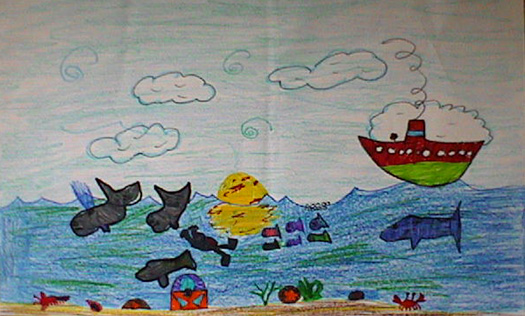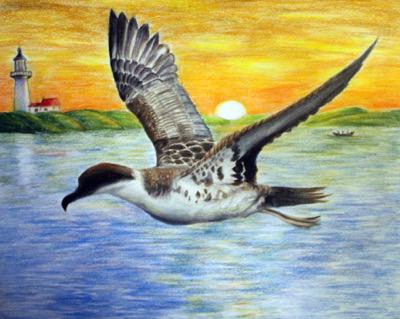
You Have to See/Sea This!
A Sanctuary History of Visual Engagement
50th Anniversary Sanctuary Signature Articles
By Elizabeth Moore | March 2022

Sea-ing is Believing
Humans rely on our senses—the five basic ones we learn in grade school plus others that are less well-known like our sense of space around our bodies (proprioception) and our sense of balance (equilibrioception)—to help us understand and interact with the world around us. For humans, although there are cultural differences, seeing is arguably our most important sense; our hearing and sense of smell, for example, are far less acute than those of some animals.
We have, perhaps even before we were fully Homo sapiens, used visual media to explain, explore, celebrate, and chronicle everything around us. Our natural world, including the ocean and its shores and wildlife, has been one of our favorite subjects for just as long. Small stone plaquettes with carvings of seals have been found in Germany that are more than 12,000 years old. A whale hunt, at least 1,000 years old and likely even older, is portrayed in rock art in Chile's Atacama Desert. Ancient cave paintings depict humpback whales in the Pacific Northwest and marine animals in rock art murals in Baja California.
At fifty, we're not quite that old but for our entire history, we too have used ocean-inspired visual media to share the ocean places we're privileged to protect, and inspired others to do the same. Let's explore those forms that have been most important to the National Marine Sanctuary System and its partners: the drawing, the photo, the painting, the poster, the film, and the virtual experience.
The Drawing
Since 2003, Stellwagen Bank National Marine Sanctuary and its partners have jointly sponsored an annual Marine Art Contest with the basic theme of exploring the biodiversity of the sanctuary. Additional partners and sponsors now include the New England Aquarium, Center for Coastal Studies, Whale and Dolphin Conservation, the Ocean Genome Project/Northeastern University, and Woods Hole Sea Grant. In 2021, prizes were offered in five categories: Grades K-4, Grades 5-8, Grades 9-12, Scientific Illustration (all grades) and Computer Graphics (all grades). Prizes included small cash awards, certificates, and museum and aquarium passes.


Each year's entries bring an abundance of amazing artwork from students all over the country and overseas in all grade levels, who create drawings of everything from the sanctuary's smallest zooplankton to bottom-dwelling flounder to free-ranging shearwaters to deep-diving right whales. Each year the winners are included in traveling displays that tour the New England region to share the wealth of offshore wildlife and to inspire people to care about and take care of them.
The Painting

Our sites contain lovely seascapes, from the wild beauty of offshore waters to the charm of sea lions lounging on rocks to picturesque marinas full of sailboats. Many such seascapes have been captured in paint for centuries, including of the places that are now sanctuaries. Artist Albert Bierstadt produced six paintings of seals in the Farallones in the 19th century, while early and mid-20th century painter Chiura Obata took some time from his famous Yellowstone National Park works to produce seascapes depicting the Monterey coastline. Among Winslow Homer's well-known maritime paintings are those of small fishing towns and beaches along the Massachusetts coastline; one of his most famous works shows the terror of sharks circling a boat in the Gulf of Mexico, home to Flower Gardens Bank National Marine Sanctuary.

While paintings aren't normally among our outreach tools, we occasionally, in partnership with the National Marine Sanctuary Foundation, have had the privilege to host an artist-in-residence. One such artist, painter Tom Freeman (1952-2015) produced several works based on sanctuaries, including those shown above, "Whales" and "Mr. Lincoln's Sanctuary".
The Photo

In the early days of the sanctuary system, photos were taken of important occasions (the earliest photo associated with our history might be one of a dedication ceremony for our first site, Monitor National Marine Sanctuary) but they weren't readily available and weren't used in many sanctuary documents. As our technology improved, so did the use and quality of our photos. The cover of the 1980 final environmental impact statement (FEIS) for the designation of Channel Islands National Marine Sanctuary, for example, included a series of black and white line drawings of scenes from around the sanctuary. We graduated to low-resolution, black and white photos for the cover of the FEIS for Florida Keys Keys National Marine Sanctuary in 1996. In contrast, the cover of the 2021 FEIS for our newest sanctuary Wisconsin Shipwreck Coast National Marine Sanctuary features a high resolution, underwater photo of a diver and shipwreck. Changing technologies, like powerful cameras built into smartphones and the rise of easily accessible and searchable online media libraries, mean that crisp, energetic photos can be used in every outreach product we create.

Such technological advances also mean that photo contests can be used to further our conservation messages and mission. Since 2016, we have hosted the Get Into Your Sanctuary Photo Contest, which each year gets hundreds of entries of gorgeous shots from all over the country. Running from Memorial Day weekend to Labor Day weekend each year, the most recent contest in 2021 had four categories: Sanctuary Views, Sanctuary Life, Sanctuary Recreation, and Sanctuaries at Home. The winners in each category are featured in various sanctuary system publications and help us get the word out about conserving our ocean and Great Lakes.
The Poster
For many years, particularly before we had easy access to high quality photos online, we relied on posters as an important outreach tool, sharing them at events and mailing them out to requesters from around the country. Posters celebrated many different kinds of resources, from the wreck of Monitor and other ships to the habitats, marine mammals, seabirds, sea turtles, fish, and invertebrates of sanctuaries, all depicted in lively, colorful drawings and illustrations. We even had the privilege of a poster designed by cartoonist Jim Toomey and featuring the characters of his widely syndicated comic strip "Sherman's Lagoon" celebrating the National Marine Protected Areas Center in 2009!
We don't produce as many posters these days, but as a throwback celebration of our 50th anniversary, we are producing a series of commemorative posters, one for each of the sites in the sanctuary system. Download those already available and join us each month as we release the next one in the series.
The Film
Film is an incredible medium, with the ability to move us in ways that sometimes still images can't. It's been a tool used to share our ocean with the world since the first underwater movie was made, a 1916 film adaptation of Jules Verne's "20,000 Leagues Under the Sea". Jacques Cousteau's early works from the 1940s may be the first marine conservation films made, but since then, many filmmakers have used video as their medium of choice to share and encourage the care of our oceanic world. Entire film festivals now devote themselves to the ocean, including the Blue Ocean Film Festival and those co-hosted by Thunder Bay and Greater Farallones national marine sanctuaries.

The sanctuary system has been the beneficiary of much film coverage over the years (we even devoted an entire issue of our newsletter "Sanctuary Watch" to film in 2013). In the 1980s and 1990s, news specials about the various recovery expeditions for the shipwreck of Monitor shared the cutting edge technology and diving expertise at work to save artifacts and structural elements of the ship. "Voyage to Kure", a film from Jean-Michel Cousteau in 2006, helped lead to the creation of Northwestern Hawaiian Islands Marine National Monument. 2011's "Project Shiphunt" told the story of five high school students as they joined the search for shipwrecks with Thunder Bay National Marine Sanctuary. Today's Stories From the Blue, a facet of our Earth is Blue campaign, are a series of short films featuring sanctuary staff, volunteers, and partners telling their ocean stories.
The Virtual Experience
Our newest visual product is one we could only have imagined a half century ago in the early days of the sanctuary system: Sanctuaries 360° Explore the Blue. These virtual dives are immersive experiences made possible by high-resolution, 3D footage, where anyone, anywhere, can swim with a playful sea lion or graceful sea turtle, explore shipwrecks, and witness coral reef restoration projects. Accompanying lesson plans allow teachers and students to learn even more from the virtual dives. These videos and lesson plans were extremely popular during the pandemic in 2020 and 2021, providing an escape for the homebound.
In 2021, Sanctuaries 360° won not one but two awards for excellence. The International Academy of the Digital Arts and Sciences nominated Sanctuaries 360° in its People's Voice science and education category, where many public supporters gave it the Webby Award, the Oscars for digital media. The Academy of Interactive and Visual Arts' 2021 Communicator Awards included an Award of Excellence in the category of online video to NOAA for Sanctuaries 360° and the Stories from the Blue series.

Conclusion
Who knows what future forms of visual media will bring? We may one day be able to virtually dive with whales or walk on the seafloor without today's bulky headsets, à la the immersive holodeck of TV's Star Trek. Or there may be whole new forms of visual art that we can't even fathom today. But we do know that whatever comes, we will continue to share the beautiful places we have the privilege to protect.


